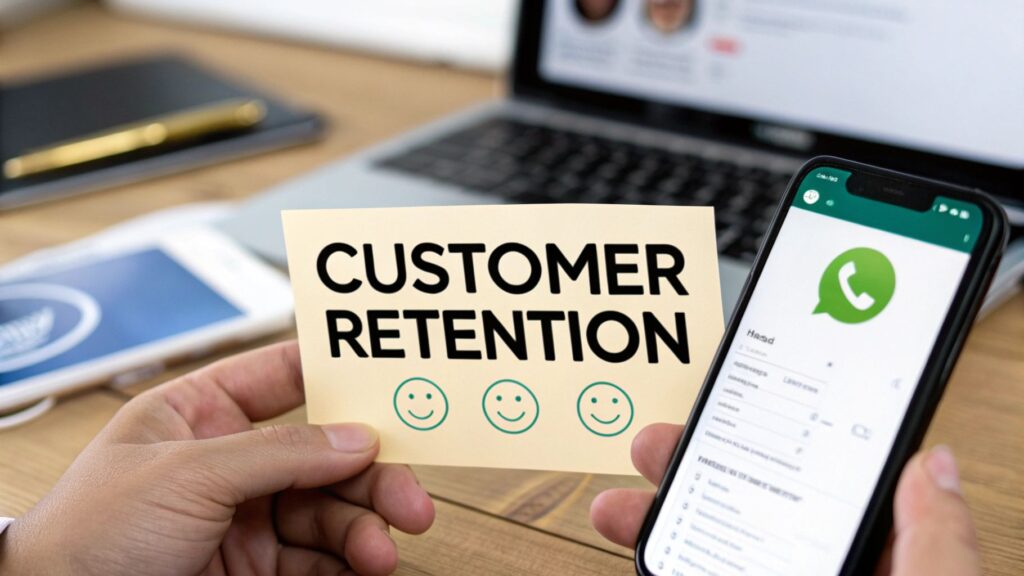In today's competitive market, attracting new customers is only half the battle. The real secret to sustainable growth lies in keeping the clients you already have. Effective customer retention strategies not only build a loyal base but also turn satisfied buyers into your most powerful marketing asset. This approach is more cost-effective than constantly seeking new business and creates a stable foundation for your enterprise.
For small businesses, especially those leveraging the direct, personal connection of WhatsApp Business, mastering retention is a game-changer. A simple tool like a virtual number can professionalise these communications, creating a dedicated channel to build lasting relationships without using your personal contact details. This guide cuts through the noise to deliver practical tactics that work.
We will walk you through 10 proven, actionable strategies designed to boost loyalty and ensure your customers keep coming back. From implementing smart loyalty programmes to personalising your communication, these insights will help you transform your small business into a trusted favourite. You will learn how to turn one-time transactions into long-term partnerships, securing your business's future and enhancing its reputation. Let's explore the methods that will make your customers want to stay.
1. Launch a Simple WhatsApp Loyalty Programme
Loyalty programs don't have to be complicated or require expensive software. For a small business, one of the most effective customer retention strategies is a straightforward loyalty scheme run through WhatsApp Business. This approach leverages a platform your customers are already comfortable with, making it personal and easy to participate in.
You can easily track customer purchases with a basic spreadsheet, updating it after each transaction. Once a customer hits a certain milestone, you reward them directly with a personalised WhatsApp message. This direct interaction builds a genuine connection and makes your customers feel truly valued, giving them a great reason to come back.
How to Implement It
This strategy is perfect for businesses like local bakeries, independent tradespeople, or e-commerce stores wanting to build a loyal following without a hefty investment. The key is to keep it manageable and make the rewards feel exclusive.
- Define Your Rewards: Offer perks that your customers will actually appreciate. This could be a free coffee after five purchases, 15% off their next service, or early access to a new product line.
- Track Progress Simply: Use a Google Sheet or even a notebook to keep a record of customer names and their purchase history. A quick daily update will keep you organised.
- Communicate Clearly: Announce the program to your customers via your WhatsApp Status or a broadcast list. Explain how it works in simple, easy-to-understand terms.
- Personalise the Reward: When a customer earns a reward, send them a personal message. For example: "Hi Sarah! Thanks for being such a loyal customer. Your next haircut is on us as a thank you!"
Key Insight: The power of a WhatsApp loyalty programme lies in its simplicity and personal touch. By managing it directly, you bypass the impersonal nature of automated systems and build stronger, more meaningful customer relationships that drive repeat business.
2. Exceptional Customer Service
Exceptional customer service isn't just about resolving issues; it's about creating consistently positive and memorable interactions at every stage. This proactive approach focuses on exceeding expectations through responsive, empathetic, and solution-focused support. It's one of the most powerful customer retention strategies because it builds an emotional connection, turning satisfied buyers into loyal advocates for your brand.
By making customers feel genuinely heard and valued, you transform service from a necessary expense into a major business advantage. This fosters a deep sense of trust and appreciation that makes customers far more likely to return, even if a competitor offers a slightly lower price.

How to Implement It
This strategy is vital for any business where personal interaction is key, from freelance consultants and skilled tradespeople to bespoke e-commerce shops. The goal is to make every customer feel like your most important one, especially when things go wrong.
- Empower Your Team: Give your front-line staff the authority to solve problems without needing to get a manager's approval. A plumber who can offer a small discount on the spot for an unforeseen delay builds more goodwill than one who has to "check with the office."
- Implement Feedback Loops: Actively ask for customer feedback through simple WhatsApp surveys or follow-up messages after a service. More importantly, act on what you learn.
- Hire for Attitude: You can train someone on the technical aspects of a job, but it's much harder to teach empathy and a positive attitude. Prioritise these traits in your hiring process.
- Address Complaints Swiftly: Acknowledge complaints immediately, even if you don't have a solution yet. A quick message like, "Hi David, I've received your email and am looking into this for you now," can prevent frustration from escalating.
Key Insight: Exceptional service isn't just about fixing problems; it's about making your customers feel respected and important. By empowering your team to deliver outstanding experiences, you build a reputation that becomes a core reason for customers to choose you again and again.
3. Personalise and Customise Your Communications
Personalisation is more than just using a customer's first name. It's about using the information you have to create experiences that feel unique to each individual. This powerful customer retention strategy makes your audience feel seen and understood, transforming a standard transaction into a meaningful relationship that builds lasting loyalty.
When customers receive recommendations, offers, or messages that reflect their past behaviour and preferences, they are far more likely to engage. Companies like Amazon and Netflix have built empires on this principle, proving that a tailored approach directly leads to repeat business and increased revenue.

How to Implement It
This strategy is vital for any small business, from an e-commerce store wanting to suggest relevant products to a tradesperson remembering a client's specific boiler model. It shows you're paying attention and value their business beyond a single sale.
- Segment Your Audience: Start by grouping customers based on their purchase history, location, or interests. You can then send targeted WhatsApp messages to each group. For example, a bakery could notify local customers about a daily special.
- Reference Past Interactions: When you communicate, mention a previous purchase or service. A simple "Hope you're still enjoying the shelves we fitted last month!" adds a powerful human touch.
- Customise Offers: Don't send generic discounts. Instead, offer a promotion related to something a customer has previously bought or shown interest in.
- Ask for Preferences: Use conversations to learn more about your customers. Gradually build a profile of their needs and preferences to better serve them in the future.
Key Insight: True personalisation isn't about complex algorithms; it's about demonstrating that you remember and understand your customers. This level of individual attention is a competitive advantage that automated systems can't easily replicate, making it one of the most effective customer retention strategies.
4. Proactive Communication and Engagement
Waiting for customers to contact you with a problem is a missed opportunity. One of the most effective customer retention strategies is to engage proactively, initiating valuable contact before issues arise. This involves sending educational content, product updates, and personalised check-ins to show your ongoing value and strengthen the relationship.
By anticipating customer needs and offering support or insights without being asked, you change the dynamic from transactional to relational. This approach, popularised by platforms like HubSpot and Salesforce, shows you are invested in your customers' success, not just their next purchase. It keeps your brand top-of-mind and builds a foundation of trust that is difficult for competitors to match.

How to Implement It
This strategy is ideal for service providers, e-commerce stores, and any business where customer education enhances the product experience. The goal is to be helpful and relevant, not intrusive, building a reputation as a trusted advisor.
- Provide Value in Every Message: Share tips on how to get the most out of your product, send links to useful blog posts, or offer industry insights. For example, a plumber could send a seasonal reminder about insulating pipes before winter.
- Segment Your Audience: Use WhatsApp labels to categorise customers based on their purchase history or interests. This allows you to send targeted, relevant messages that resonate more effectively.
- Set Up Smart Triggers: Use your virtual number to automate check-ins. A tradesperson could set a reminder to message a client a month after a job to ask if everything is still working perfectly.
- Personalise Your Check-ins: Instead of a generic broadcast, send individual messages. A simple, "Hi David, just checking in to see how you're getting on with the new boiler. Let me know if you have any questions!" goes a long way.
Key Insight: Proactive communication shifts your role from a reactive seller to a valuable partner. By consistently offering help and insights, you create an environment where customers feel supported and understood, making them significantly more likely to remain loyal.
5. Subscription and Membership Models
Turning one-time buyers into committed, long-term customers is one of the most powerful customer retention strategies available. Subscription and membership models create an ongoing relationship through recurring payments, providing continuous value and making it less likely for customers to switch to a competitor. This approach generates a predictable revenue stream and builds a loyal community around your brand.
Companies like Dollar Shave Club mastered this by turning a simple purchase (razors) into a convenient monthly service. This model locks in future sales and gives you a direct, ongoing channel to engage with your customers. Instead of constantly chasing new sales, you can focus on delivering consistent value to your existing subscriber base, ensuring they remain satisfied.
How to Implement It
This strategy is ideal for businesses that offer replenishable products or ongoing services. Think of a local coffee roaster offering a monthly bean delivery, a tradesperson providing a yearly maintenance plan, or a content creator offering exclusive content via a membership. The key is to provide value that justifies the recurring cost.
- Define Your Value: Clearly outline what subscribers get each month. This could be a physical product, exclusive content, priority service, or members-only discounts.
- Choose a Platform: Use tools like WooCommerce Subscriptions, Patreon, or MemberPress to manage recurring payments and member access easily.
- Offer Flexible Tiers: Create different pricing levels to cater to various budgets and needs. A basic tier could offer core products, while a premium tier includes extra perks.
- Focus on the Experience: Make it easy to sign up and, importantly, easy to cancel. A transparent cancellation process builds trust and makes customers more likely to return later.
Key Insight: A successful subscription model isn't just about recurring revenue; it's about building a predictable relationship. By delivering consistent and tangible value, you shift the customer mindset from a one-off transaction to a long-term partnership, creating a powerful engine for customer retention.
6. Solicit Customer Feedback for Continuous Improvement
One of the most effective customer retention strategies is to actively listen to what your customers are saying. Creating a system to collect, analyse, and act on customer feedback shows you value their opinions and are committed to evolving your business to better meet their needs. This approach turns customers into partners in your growth, fostering deep-seated loyalty.
By regularly asking for feedback, you gain invaluable insights into what you’re doing right and where you can improve. This continuous improvement cycle not only enhances your product or service but also makes customers feel heard and respected. Companies like Slack and Airbnb built their entire platforms around this principle, constantly refining their offerings based on user suggestions, which creates a product that customers don't want to leave.
How to Implement It
This strategy is vital for any business aiming for long-term success, from an e-commerce store fine-tuning its checkout process to a plumber asking how they can improve their service. It's about making your customers feel like their voice genuinely matters.
- Use Multiple Channels: Don't rely on a single method. Use WhatsApp polls, simple email surveys after a purchase, or even just ask for feedback during a conversation. Make it as easy as possible for customers to share their thoughts.
- Set Up Automated Triggers: Use WhatsApp Business to send an automated message 24 hours after a service is completed or a product is delivered. For example: "Hi James, we hope you're enjoying your new boiler. We'd love to hear any feedback you have on our service!"
- Close the Feedback Loop: When you implement a change based on feedback, announce it. Send a broadcast message saying, "You asked, we listened! Our booking process is now even simpler." This shows customers their input has a real impact.
- Train Your Team: Ensure anyone interacting with customers knows how to professionally ask for and receive feedback, both positive and negative.
Key Insight: Customer feedback isn't just about fixing problems; it's about co-creating a better business with the people who matter most. By actively involving your customers in your improvement process, you transform them from simple buyers into loyal advocates for your brand.
7. Value-Added Services and Benefits
Offering value-added services means going beyond your core product; it's about providing extra benefits that solve related problems for your customers. This is a powerful customer retention strategy because it increases the "cost" of switching and embeds your business into a customer’s routine. By offering more than the basics, you give customers compelling reasons to stay, even if a competitor has a similar core product.
Think of a local electrician who not only fixes a wiring issue but also offers a complimentary annual safety check, or an e-commerce store that provides free, expert-led tutorials on how to use their products. These extras build a deeper relationship and demonstrate that you genuinely care about the customer's overall success and well-being, fostering significant loyalty.
How to Implement It
This strategy is ideal for businesses looking to stand out in a crowded market, from independent tradespeople to digital service providers. The goal is to offer perks that are highly relevant to your customers' needs and enhance their experience with your primary offering.
- Align Services with Customer Needs: If you're a plumber, offer an optional annual boiler service plan. If you sell artisan coffee, provide free access to a monthly virtual brewing workshop.
- Communicate the Value Clearly: Ensure your customers know about these benefits. Use your WhatsApp Business profile, status updates, and direct messages to highlight what extras they receive.
- Bundle Services Strategically: Create tiered packages that bundle your core service with value-added benefits. This increases the perceived value and encourages customers to invest more deeply in your business.
- Train Your Team: Make sure anyone interacting with customers can clearly explain the benefits of your additional services and why they are valuable.
Key Insight: Value-added services transform your business from a simple supplier into an indispensable partner. When you solve more of your customer's problems, you become harder to replace, effectively locking in their loyalty and driving long-term retention.
8. Community Building and Social Engagement
Transforming customers into a community is one of the most powerful customer retention strategies you can use. This approach moves beyond simple transactions to foster a sense of belonging and shared identity around your brand. By creating a space where customers can connect with each other and your business, you build deep emotional loyalty that turns buyers into genuine advocates.
This strategy works because it taps into our fundamental human need for connection. When customers feel like part of a group, their relationship with your brand becomes more meaningful. Brands like Harley-Davidson (with its H.O.G. community) have shown that a strong community can create lifelong loyalty that competitors find almost impossible to break.
How to Implement It
This strategy is ideal for businesses with a passionate customer base, such as niche e-commerce stores, fitness instructors, or creative professionals. It's about creating an exclusive club that people are proud to be part of, strengthening your customer retention efforts.
- Create a Hub: Use a private Facebook Group, a dedicated WhatsApp community, or a Discord server as a central place for your members to interact.
- Encourage User Content: Run contests or create weekly prompts asking customers to share photos or stories related to your products or services. Feature the best submissions.
- Provide Exclusive Value: Offer community-only benefits like early access to new products, exclusive discounts, or members-only Q&A sessions with you.
- Actively Participate: Don't just set up the group and leave it. Engage in discussions, answer questions, and make your presence felt. This shows you value the community you’ve built.
Key Insight: Community building isn’t about selling; it's about connecting. By focusing on fostering genuine relationships between your customers and your brand, you create an unshakeable foundation of loyalty that goes far beyond the initial purchase.
9. Win-Back and Re-engagement Campaigns
It's often more cost-effective to bring back a former customer than to acquire a new one. A highly effective customer retention strategy involves launching targeted win-back campaigns on WhatsApp to reconnect with customers who have gone quiet. These campaigns are designed to understand why they left and offer a compelling reason to return.
By reaching out personally via WhatsApp, you can reignite the relationship and show inactive customers you still value their business. A well-timed message acknowledging their absence and presenting a tailored offer—like Spotify’s personalised "come back" playlists—can remind them of the value you provide and successfully bring them back into the fold.
How to Implement It
This strategy is perfect for businesses with a recurring purchase model, such as subscription services, local tradespeople with regular clients, or e-commerce stores. The goal is to re-engage customers who haven't made a purchase or used a service in a specific timeframe, like 60-90 days.
- Identify Inactive Customers: Segment your customer list to identify those who haven't engaged recently. This could be based on their last purchase date or appointment.
- Craft a Compelling Offer: Don’t just send a standard discount. Provide genuine value. You could highlight new features, offer an exclusive service bundle, or provide a special "welcome back" gift with their next order.
- Time Your Message Right: Wait for a reasonable period before reaching out. A message sent 90 days after their last interaction often hits the sweet spot between being proactive and respecting their space.
- Personalise Your Outreach: Start your WhatsApp message by acknowledging their absence respectfully. For example: "Hi Tom, we've missed you! To welcome you back, we'd like to offer you 20% off your next plumbing service."
Key Insight: A successful win-back campaign isn't just about discounts; it's about showing you've noticed a customer's absence and are actively working to earn back their trust. Using a direct channel like WhatsApp makes this outreach feel personal and significantly increases its effectiveness.
10. Implement Customer Success and Onboarding Programmes
A structured onboarding program is one of the most critical customer retention strategies you can employ. It guides new customers through the initial stages of using your product or service, ensuring they get value quickly and understand how to achieve their goals. This early support prevents confusion and frustration, setting the foundation for a long-term, loyal relationship.
By proactively teaching customers how to succeed, you demonstrate your commitment to their outcomes, not just the sale. This approach is particularly effective for services or products with a learning curve, like a new software tool, a coaching package, or even a complex piece of equipment. Companies like Slack and Canva excel at this by offering interactive tutorials and step-by-step guidance.
How to Implement It
This strategy is ideal for businesses where customer education is key to satisfaction, such as digital agencies, personal trainers, or tradespeople installing new systems. The goal is to make the customer feel confident and capable from day one.
- Map Key Milestones: Identify the first few crucial steps a customer must take to see value. For a plumber installing a smart thermostat, this might be programming their first schedule.
- Create Simple Guides: Develop short video tutorials, a printable one-page guide, or a series of WhatsApp messages explaining the core features.
- Schedule a Check-In: A week after a service or purchase, send a quick message: "Hi David, just checking in. How are you getting on with the new boiler controls? Let me know if you have any questions!"
- Celebrate Their Wins: Acknowledge when they reach a milestone. A simple "Great job setting up your weekly reports!" can make a customer feel accomplished and supported.
Key Insight: Customer success isn't just for software companies. By formalising your onboarding process, you transform a one-time transaction into a supportive partnership, significantly reducing churn and building a base of advocates for your business.
Customer Retention Strategies Comparison
| Strategy | Implementation Complexity 🔄 | Resource Requirements ⚡ | Expected Outcomes 📊 | Ideal Use Cases 💡 | Key Advantages ⭐ |
|---|---|---|---|---|---|
| Loyalty and Rewards Programs | High setup and ongoing management 🔄 | Significant investment in technology & staff ⚡ | Increased purchase frequency, higher order value 📊 | Retail, e-commerce, subscription businesses 💡 | Drives repeat business, valuable customer data ⭐ |
| Exceptional Customer Service | High due to training and multi-channel support 🔄 | High operational costs and staff needs ⚡ | Strong emotional connections, reduced churn 📊 | Service industries, luxury brands, high-touch sectors 💡 | Builds loyalty, competitive differentiation ⭐ |
| Personalization and Customization | Complex AI and data integration 🔄 | High cost for data management and tech ⚡ | Higher conversion rates, improved satisfaction 📊 | E-commerce, digital platforms, SaaS 💡 | Boosts sales, reduces marketing waste ⭐ |
| Proactive Communication & Engagement | Moderate complexity; requires content planning 🔄 | Moderate ongoing content and analytics ⚡ | Increased engagement, prevents issues 📊 | SaaS, financial services, education platforms 💡 | Enhances retention, strengthens brand recall ⭐ |
| Subscription and Membership Models | Complex billing and management systems 🔄 | High initial acquisition cost, ongoing service ⚡ | Predictable revenue, higher lifetime value 📊 | SaaS, consumer goods, media streaming 💡 | Recurring revenue, natural retention barrier ⭐ |
| Customer Feedback & Continuous Improvement | Moderate; needs feedback systems & analysis 🔄 | Requires dedicated tools and teams ⚡ | Product/service innovation, reduced churn 📊 | All industries aiming for continuous growth 💡 | Drives innovation, builds customer trust ⭐ |
| Value-Added Services and Benefits | Moderate to high; involves additional offerings 🔄 | Increased operational complexity and costs ⚡ | Higher lifetime value, increased switching costs 📊 | Tech products, retail, financial services 💡 | Differentiates brand, creates additional revenue ⭐ |
| Community Building & Social Engagement | Moderate; ongoing monitoring and moderation 🔄 | Resources for community management ⚡ | Strong emotional bonds, user-generated content 📊 | Lifestyle brands, tech, hobbies, fitness 💡 | Builds loyalty, lowers service costs ⭐ |
| Win-Back and Re-engagement Campaigns | Moderate; requires segmentation and automation 🔄 | Marketing team and tools for campaigns ⚡ | Recover lost customers, improve lifetime value 📊 | All businesses with churned customer base 💡 | Cost-effective retention, insight on churn reasons ⭐ |
| Customer Success and Onboarding Programs | High due to personalized touch and training 🔄 | High initial investment in onboarding staff ⚡ | Reduced early churn, increased adoption 📊 | SaaS, complex products, B2B services 💡 | Builds long-term relationships, early risk detection ⭐ |
Turning Conversations into Lasting Loyalty
Mastering customer retention isn't about implementing complex marketing theories or investing in expensive software. As we've seen, the foundation of lasting loyalty is surprisingly straightforward: it's about building genuine, human connections and consistently delivering value. For small businesses, freelancers, and independent professionals, this is a huge advantage. You have the agility and personal touch that larger corporations often lack.
The common thread weaving through these strategies is the importance of a direct line to your customer. By using accessible tools like WhatsApp Business with a dedicated virtual number, you can professionalise these interactions. This combination turns a simple messaging app into a robust platform for implementing sophisticated customer retention strategies without the hefty price tag. You’re no longer just another contact in a phone; you're a reliable and caring business partner.
Your Actionable Roadmap to Higher Retention
To avoid feeling overwhelmed, don't try to implement all ten strategies at once. Instead, choose one or two that align most closely with your business and your customers' needs right now.
- For immediate impact: Focus on Exceptional Customer Service and Customer Feedback. These foundational strategies create a positive feedback loop, helping you solve problems quickly and showing customers you value their opinions.
- For long-term growth: Begin building a simple Loyalty and Rewards Programme or a Community around your brand. These initiatives require consistent effort but pay enormous dividends in creating a tribe of dedicated advocates.
The key is to start small, be consistent, and listen intently. Each message you send, every piece of feedback you act upon, and every personalised offer you create is an investment in your customer relationships. These small, consistent efforts compound over time to build an unshakeable foundation of trust and loyalty.
Ultimately, these customer retention strategies empower you to shift your focus from constantly chasing new leads to nurturing the valuable relationships you’ve already built. This approach is not only more cost-effective but also more fulfilling. It transforms your customer list from a series of transactions into a thriving community that actively supports and champions your success. Start today, be genuine in your approach, and watch as your customers become your greatest asset.
Ready to professionalise your customer communication and implement these retention strategies seamlessly? Secure a dedicated virtual number from Business Numbers Direct to manage all your WhatsApp Business conversations from one organised, professional hub. Visit Business Numbers Direct to get started in minutes and turn your customer conversations into lasting loyalty.




